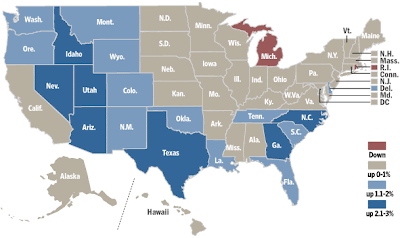
Those of you who lived in California during the early 1990s no doubt remember the exodus of friends and associates to other states such as Nevada, Arizona, Washington, Oregon and Colorado. Some people said that this meant the end for California -- that it would no longer be able to compete due to high taxes, an anti-business environment and high housing prices. What it DID mean were some great buying opportunities for those who were patient enough to wait until the next boom.
For those who left the state, many moved back when the housing market improved, in large part because they missed the entertainment, cultural and restaurant options here. Oh, sure, you might save a bundle by moving to Carson City, Nevada, but once you get used to your lower house payment, then what? Knitting circles? Strip Monopoly?
Well, apparently it's happening again, and this Wall Street Journal article concludes it's due to the declining housing market:
Population growth in several of the fastest-growing states is slowing -- in Arizona, Florida and Nevada, in particular -- in a trend both reflecting and fueling the housing-market malaise in those areas. "This is our first chance to see what has been the migration impact of the housing-market slowdown, and it's showing up in these highflying states," says William Frey, a demographer at the Brookings Institution, a Washington think tank.
The Census Bureau's annual estimate of state population changes covers the 12 months that ended July 1. It shows that people continue to flee the Midwest -- especially Michigan, one of two states to lose people -- and that the Mountain states in the West continue to post large population gains as people arrive from California and elsewhere...
In the most recent period, 263,035 people left California for another state. The state's 0.8% population growth was mostly because of births.Still, because of California's huge population base, it still added over 300,000 new residents, mostly due to new births. That will continue to mean demand for larger homes and/or new households, which will help the state work off its inventory load faster than many other states. Of course this will vary considerably by area, with the inland areas taking much longer to reach supply-demand equilibrium.




1 comment:
Many of us predicted exactly what has happened to California, years ago.
Take Housing:
Back in 1998 and even as late as 2002 when everyone was saying to buy homes in places like Los Angeles and San Diego many of us looked with bewilderment. Home prices in these areas were over valued back then and they still are today. The income to housing cost data shows that the median house should cost around 200k in San Diego. This is exactly where prices are headed. Prices will continue to fall with a few small bounces in certain areas, but you will not see a real bottom until 2012 or 2013. When this bottom is put it you will not see a ramp up of any sort. Adjusted for inflation homes in California, particularly in Los Angeles and San Diego will be lower 15 years from now. There is no catalyst for a California housing boom. California no longer gets the huge influx of migrants from other parts of the United States. These educated folk that California could count on since after WWII no longer chose California. In fact, the educated are leaving California in droves, destined for much better managed states such as Texas, Colorado, Oregon, Utah, Nevada, and Arizona. Georgia and the Carolina's as well. The demographic shift spells longer term, certain trouble for Southern California real estate. The uneducated hispanic population is not going to produce the wealth needed to support sky high home valuations. This will begin to be evident by 2025. The long term forecast for California, for the entire state of California, is dismal at best.
Post a Comment